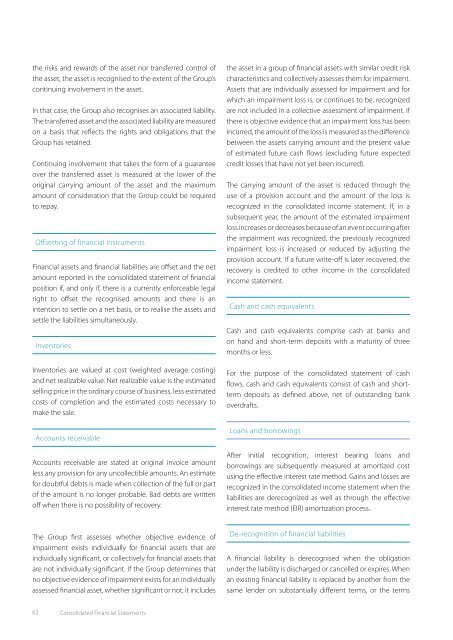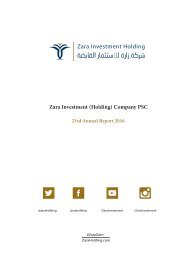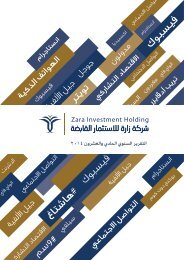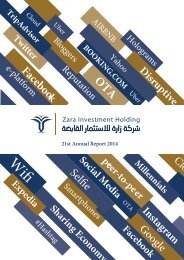ZaraAnnual-English2013
Create successful ePaper yourself
Turn your PDF publications into a flip-book with our unique Google optimized e-Paper software.
the risks and rewards of the asset nor transferred control of<br />
the asset, the asset is recognised to the extent of the Group’s<br />
continuing involvement in the asset.<br />
In that case, the Group also recognises an associated liability.<br />
The transferred asset and the associated liability are measured<br />
on a basis that reflects the rights and obligations that the<br />
Group has retained.<br />
Continuing involvement that takes the form of a guarantee<br />
over the transferred asset is measured at the lower of the<br />
original carrying amount of the asset and the maximum<br />
amount of consideration that the Group could be required<br />
to repay.<br />
Offsetting of financial instruments<br />
Financial assets and financial liabilities are offset and the net<br />
amount reported in the consolidated statement of financial<br />
position if, and only if, there is a currently enforceable legal<br />
right to offset the recognised amounts and there is an<br />
intention to settle on a net basis, or to realise the assets and<br />
settle the liabilities simultaneously.<br />
Inventories<br />
Inventories are valued at cost (weighted average costing)<br />
and net realizable value. Net realizable value is the estimated<br />
selling price in the ordinary course of business, less estimated<br />
costs of completion and the estimated costs necessary to<br />
make the sale.<br />
Accounts receivable<br />
Accounts receivable are stated at original invoice amount<br />
less any provision for any uncollectible amounts. An estimate<br />
for doubtful debts is made when collection of the full or part<br />
of the amount is no longer probable. Bad debts are written<br />
off when there is no possibility of recovery.<br />
the asset in a group of financial assets with similar credit risk<br />
characteristics and collectively assesses them for impairment.<br />
Assets that are individually assessed for impairment and for<br />
which an impairment loss is, or continues to be, recognized<br />
are not included in a collective assessment of impairment. If<br />
there is objective evidence that an impairment loss has been<br />
incurred, the amount of the loss is measured as the difference<br />
between the assets carrying amount and the present value<br />
of estimated future cash flows (excluding future expected<br />
credit losses that have not yet been incurred).<br />
The carrying amount of the asset is reduced through the<br />
use of a provision account and the amount of the loss is<br />
recognized in the consolidated income statement. If, in a<br />
subsequent year, the amount of the estimated impairment<br />
loss increases or decreases because of an event occurring after<br />
the impairment was recognized, the previously recognized<br />
impairment loss is increased or reduced by adjusting the<br />
provision account. If a future write-off is later recovered, the<br />
recovery is credited to other income in the consolidated<br />
income statement.<br />
Cash and cash equivalents<br />
Cash and cash equivalents comprise cash at banks and<br />
on hand and short-term deposits with a maturity of three<br />
months or less.<br />
For the purpose of the consolidated statement of cash<br />
flows, cash and cash equivalents consist of cash and shortterm<br />
deposits as defined above, net of outstanding bank<br />
overdrafts.<br />
Loans and borrowings<br />
After initial recognition, interest bearing loans and<br />
borrowings are subsequently measured at amortized cost<br />
using the effective interest rate method. Gains and losses are<br />
recognized in the consolidated income statement when the<br />
liabilities are derecognized as well as through the effective<br />
interest rate method (EIR) amortization process.<br />
of an existing liability are substantially modified, such an<br />
exchange or modification is treated as a de-recognition of the<br />
original liability and the recognition of a new liability, and the<br />
difference in the respective carrying amounts is recognised in<br />
the consolidated income statement.<br />
Borrowing costs<br />
Borrowing costs directly attributable to the acquisition,<br />
construction or production of an asset that necessarily takes a<br />
substantial period of time to get ready for its intended use or<br />
sale are capitalized as part of the cost of the respective assets.<br />
All other borrowing costs are expensed in the period they<br />
occur. Borrowing costs consist of interest and other costs that<br />
an entity incurs in connection with the borrowing of funds.<br />
Accounts payable and accruals<br />
Trade payables are obligations to pay for goods or services<br />
that have been acquired in the ordinary course of business<br />
from suppliers.<br />
Provisions<br />
Provisions are recognized when the Group has a present<br />
obligation (legal or constructive) as a result of a past event,<br />
it is probable that an outflow of resources embodying<br />
economic benefits will be required to settle the obligation<br />
and a reliable estimate can be made of the amount of the<br />
obligation. Where the Group expects some or all of a provision<br />
to be reimbursed, for example under an insurance contract,<br />
the reimbursement is recognised as a separate asset but only<br />
when the reimbursement is virtually certain. The expense<br />
relating to any provision is presented in the consolidated<br />
income statement net of any reimbursement.<br />
Income Taxes<br />
The income tax provisions is calculated in accordance with<br />
the Temporary Income Tax Law No. 28 of 2009.<br />
Tax expense comprises current tax and deferred taxes.<br />
Deferred tax is provided on temporary differences at each<br />
reporting date between the tax bases of assets and liabilities<br />
and their carrying amounts for financial reporting purposes.<br />
Deferred tax assets and liabilities are measured at the tax<br />
rates that are expected to apply in the period when the asset<br />
is realized or the liability is settled.<br />
The carrying values of deferred income tax assets are<br />
reviewed at each reporting date and reduced to the extent<br />
that it is no longer probable that sufficient taxable profit will<br />
be available to allow all or part of the deferred income tax<br />
asset to be utilized.<br />
The Group first assesses whether objective evidence of<br />
impairment exists individually for financial assets that are<br />
individually significant, or collectively for financial assets that<br />
are not individually significant. If the Group determines that<br />
no objective evidence of impairment exists for an individually<br />
assessed financial asset, whether significant or not, it includes<br />
De-recognition of financial liabilities<br />
A financial liability is derecognised when the obligation<br />
under the liability is discharged or cancelled or expires. When<br />
an existing financial liability is replaced by another from the<br />
same lender on substantially different terms, or the terms<br />
62 Consolidated Financial Statements Annual Report 2013 63
















